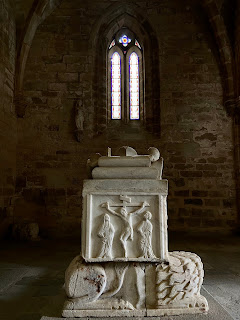The train station is south, and the first thing you see when you step out of the building are grain silos. The station itself is quite cute; from the mid-century, it is covered with charming and colorful (not just blue and white) azulejos panels with local scenes; but it seems to be in the middle of nowhere. The approach to town is down a lengthy road, through the buildings of a GNR command center and academy, and then a chalky, barren parking zone (Praça do Rossio). My expectations of the day are nearly undone, but once inside the city walls, it feels like Évora again.
One of the sites we want to revisit is the Capela dos Ossos (bones chapel), which is under the Mosteiro de São Francisco. It's on the south-side, so after a brief stop for café, we head there first. It is as macabre and charming as I remember. One thing of note is the tile wainscot in the antechamber; the colorful patterns and the cherubs don't quite prepare you for the chapel. Because of COVID-19, only ten living people are permitted in the space at a time, and I am able to linger and commune with the dead. There are two mummies which I don't recall from our visit in November (photos prove that they were there). Evidently, the monks used to hang mummies as a further reminder of our limited time on earth; I think they may be over-doing it.
It's overcast and a touch humid, but not hot. The streetscape is picturesque in all the right ways for an old city, with proper quantities of patina and decay, along with animated stone finials and iron railings. We head for the Sé and approach it from behind, which brings us around to the Templo Romano. The area is devoid of tourists, as I recall waiting for all the selfie artists to clear on our last trip; it's a real treat to have the square to ourselves, surrounded by doorways and masonry representing so many eras.
A new site that I thought would be interesting is the Palácio da Inquisição. Évora is listed as one of the most active sites for the Inquisition Courts in Portugal, but the building has been taken over by the local cultural office (Fundação Eugénio de Almeida). It is now a very modern community space. I thought that a town famous for its Capela dos Ossos would play up the Palácio, but any evidence of its dark past is absent. There are good views out to the Templo, and the ceilings in the Sala do Tribunal and the Cubículo do Inquisidor are restored, but the rest is fresh, new exhibition space and well-kept bathrooms.
After lunch, we finish our day at the Sé. Again, because of COVID-19, visitors are asked to follow a specific path: Torre, Claustros, and Catedral. Unfortunately, the roof of the Claustros is closed.
Though I remember the unusual altar with the pregnant Virgin placed awkwardly in the middle of the nave, I don't remember the very odd, egg-headed figure of the Salvador do Mundo above her. I place myself against the candle stand and look up to see if a perspective trick is at play. It is not; He still looks egg-headed. Knowing the piece is an Annunciation (her banner reads: Ecce ancilla doomini), I look for Gabriel and find him on the opposite column, on a simple stand (am unsure the meaning of the creatures beneath him). It is uniquely creative, to engage the space between the worshippers.
Another detail I revisit is the false-perspective barrel vaults over the side chapels. In this case, the perspective effect is successful, especially looking down the aisle from the front of the church. But we are being directed from back to front today, so I turn and take a long minute to relish the result before departing.
Georgia's COVID-19 case-count, seven-day average is down below seventeen hundred; Portugal's is up close to six hundred. Family back home ask how Portugal is doing, and I tell them things are not good lately – but it's all relative. Things are better in Georgia, but things are awful. Things are worse in Portugal, but they aren't bad.
There are over thirty million cases world-wide. There are over two hundred thousand deaths in the US. Georgia will probably pass three hundred thousand cases tomorrow.
cases: 30,037,119 global • 6,828,301 USA • 65,626 Portugal
deaths: 944,715 global • 201,348 USA • 1,878 Portugal

























No comments:
Post a Comment